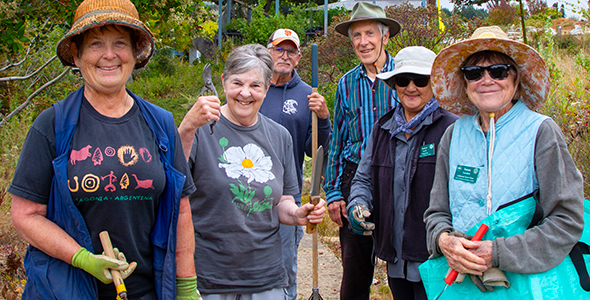Linda Anderson (B.S. ’81 Earth sciences; M.S. ’84; Ph.D. ’89) has been a volunteer with the UC Santa Cruz Arboretum and Botanic Garden since she retired from the university over 15 years ago. Anderson is a lifelong nature lover with deep roots at UC Santa Cruz—it only makes sense that she would spend her retired years tending UCSC’s largest garden.
After completing her first undergraduate degree in zoology and chemistry at UC Berkeley, Anderson moved to Santa Cruz in 1976. She got involved in environmental activism and lobbied the California Board of Forestry, advocating for select harvest in Santa Cruz County. Anderson became more invested in protecting California’s natural environment, particularly in regard to timber harvesting. This prompted her to pursue a second bachelor’s degree in geology at UCSC.
Following her undergraduate studies, she continued her education in Earth sciences, earning her master’s degree and Ph.D. from UCSC with a focus on geochemistry. After a stint at the US Geological Survey, Anderson returned to UCSC in 1996 until her retirement in 2012. Her research focused on the chemical composition of oceans over geologic time-scales, the field of paleoceanography. These studies utilize chemical signatures captured in oceanic sediment cores laid down over millions of years. One unicellular organism, foraminifera, incorporates trace elements into its shell depending on the pH and temperature of the surrounding ocean, providing insights into past climates. This information provides valuable insights into the earth’s response to climate change.
While she enjoyed studying and teaching the wonders of the ocean, being a chemist meant she had to stay inside a lab when she really wanted to be outside exploring nature. “I realized that when I retired I wanted to be outside,” Anderson says.
Anderson began volunteering with the Arboretum two years before she retired. Out of the four gardens—three of which feature plants from afar in Australia, New Zealand, and South Africa—Anderson knew that she wanted to dedicate her time to local indigenous plants in the California Natives Garden.
Growing up in Pasadena, Anderson’s love for nature began with California native plants as they were near and dear to her mother. “When my family went camping, my mom brought her natural history books,” Anderson says. Her mother also grew native plants at home. While this exposure started Anderson down the path of natural history research as a geochemist, she was excited to return as a retiree to what prompted her love for nature in the first place—studying and protecting California native plants.
As a volunteer coordinator at the Arboretum, Anderson leads two volunteer groups during the week: one on Tuesday morning tending the California Native Garden in the front of the arboretum and another on Thursday morning with the Conservation Garden in the upper section of the Arboretum. The volunteers are a mix of undergraduates, an enthusiastic computer science masters student, and retirees.
While her Tuesday volunteer group maintains the front-facing Native California Garden, Anderson has more creative license to start new projects in the Conservation Garden. In the last few years, Anderson established a coastal prairie habitat. Inspired by the Upper Marshall Meadow near her Felton home, she took seeds from endangered plants that only exist in the Upper Marshall Meadow to propagate and plant.
“Coastal prairies are the most endangered plant community. I think they are spectacular, especially in spring when there are lots of flowers,” Anderson says. In the first year of the project, she planted two rare species from the meadow and was ecstatic to see them seed out the next year, solidifying the plants’ longevity in the garden.
“I love the people I work with and who oversee me,” she says referring to the seven paid staff at the Arboretum. “The wonderful thing about this place is its staff. Not only do they appreciate volunteers, but they are very supportive”.
The Arboretum staff are always there to provide tools and frequently greet volunteers by name, lifting them up. She says she feels like she is treated like staff because of her long-time involvement and the expertise she brings to the arboretum. There are many ways that people can volunteer at the garden from weeding and pruning plants to working at the gift shop and talking to visitors about the garden. Volunteers can come on a weekly basis or simply come to a singular event.
“There is something for everyone here,” Anderson says.
In addition to her passion for plants and the Arboretum, Anderson is a staunch supporter of students at UC Santa Cruz. She has established scholarships in memory of her parents, Marilyn C. and Raymond E. Davis as well as made other generous gifts to the university. Her roots are indeed deep at UC Santa Cruz.
To learn more about volunteer opportunities with the UCSC Arboretum, visit here.



